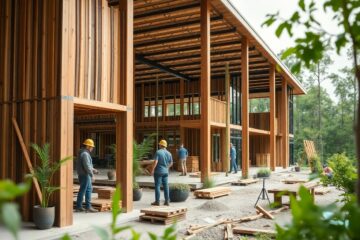Rediscovering Traditional Building Materials – Homes That Embrace Nature
In the realm of modern construction, the revelation of traditional building materials has gained momentum as a sustainable and environmentally friendly approach to housing. Embracing natural elements such as wood, stone, and clay, these homes seamlessly integrate with their surroundings while offering a myriad of benefits for both inhabitants and the planet. From improved thermal insulation and indoor air quality to reduced carbon footprint and overall aesthetic appeal, these time-honored materials are proving to be a compelling choice for architects and homeowners alike. In this blog post, we will delve into the perils of modern building materials, the virtues of their traditional counterparts, and the resurgence of homes that harmonize with nature.
Table of Contents
Traditional Building Materials
Before the rise of modern construction materials, civilizations relied on traditional building materials such as wood, stone, clay, and bamboo to construct homes that seamlessly blended with the natural environment. Rediscovering these materials presents an opportunity to embrace sustainable architecture that is both environmentally friendly and aesthetically pleasing.
Wood: The Backbone of Sustainable Architecture
Building with wood has been a cornerstone of construction for centuries, and for good reason. Wood is a renewable resource that can be sourced sustainably, making it an ideal choice for environmentally conscious builders. Additionally, wood offers natural insulation, reducing energy consumption and contributing to a more comfortable living space. Its versatility allows for a range of architectural designs, from classic to modern, while providing structural strength and durability.
Stone: Durability and Aesthetic Appeal
Traditional stone buildings exude timeless beauty and unparalleled durability. Stone is renowned for its strength and ability to withstand the test of time, making it a reliable choice for sustainable architecture. Its natural aesthetic appeal adds a sense of authenticity to homes and buildings, blending seamlessly with the surroundings while requiring minimal maintenance.
Architecture that incorporates stone exudes a sense of permanence and stability, creating an environment that resonates with the natural landscape.
Clay and Mud: Eco-friendly Choices
The use of clay and mud for construction dates back to ancient times, and it continues to be a sustainable choice for modern builders. Clay and mud offer natural insulation, regulating indoor temperatures for energy efficiency. These materials are readily available and can be sourced locally, reducing the environmental impact of transportation. Additionally, clay and mud structures have a distinct charm, connecting inhabitants to the Earth and creating a sense of harmony with nature.
Durability, affordability, and biodegradability make clay and mud an ideal choice for sustainable architecture, ensuring that homes are not only environmentally friendly but also built to withstand the test of time.
Bamboo: Versatility and Strength
Materials sourced from bamboo offer a unique combination of versatility and strength, making them an attractive option for sustainable construction. Bamboo is a rapidly renewable resource that can be harvested without causing harm to the environment. Its natural flexibility allows for innovative architectural designs, while its strength rivals that of traditional building materials.
Plus, bamboo’s natural resistance to pests and decay makes it an ideal choice for homes in diverse climates, ensuring longevity and sustainability.
Techniques in Traditional Construction
Keep the tradition alive by rediscovering the techniques in traditional construction that have been passed down through generations. From timber framing to cob construction, thatching, and stone masonry, these age-old methods offer sustainable and beautiful ways to build homes that embrace nature.
Timber Framing: An Age-old Tradition
The art of timber framing dates back centuries, with its sturdy and durable structures showcasing the skill and craftsmanship of traditional builders. The use of interlocking wooden joints and beams allows for the creation of large, open spaces without the need for modern materials like steel or concrete. Timber-framed homes are not only visually appealing, but they also offer excellent insulation properties, making them ideal for energy-efficient living.
Cob Construction: A Revival of Interest
An ancient building technique that is experiencing a revival of interest, cob construction involves using a mixture of clay, sand, and straw to create strong and sturdy walls. The simple and environmentally friendly nature of cob construction makes it an attractive option for sustainable housing projects. Its thermal mass properties regulate indoor temperatures, offering a comfortable living environment while reducing the need for artificial heating and cooling.
A resurgence in cob construction is driven by the desire for eco-friendly building materials and the embrace of natural, earthy aesthetics in modern architecture. Its fire-resistant and mold-resistant qualities further enhance its appeal as a traditional building material.
Thatching: Natural Insulation
To provide natural insulation and weatherproofing, thatching involves covering a roof with layers of dry vegetation such as straw, reed, or grass. The use of natural materials not only adds rustic charm to a home but also offers excellent insulation against heat and cold. Thatched roofs are not only durable but also environmentally friendly, as the materials are often locally sourced and biodegradable.
Stone Masonry: The Art of Building without Cement
An enduring and sustainable building technique, stone masonry relies on carefully shaping and stacking individual stones to create resilient structures. The use of stone as a building material provides exceptional strength and durability, with structures that can withstand the test of time. Stone masonry allows for the creation of stunning architectural features, adding a timeless appeal to homes and buildings.
Thatching, cob construction, and stone masonry offer a glimpse into the rich tapestry of traditional building methods, demonstrating the ingenuity and sustainability of materials sourced from the natural environment. Embracing these techniques not only fosters a deeper connection to the land but also promotes the use of renewable and eco-friendly materials in modern construction.
Modern Adaptations
Not just confined to the past, traditional building materials are finding new life in modern construction. As we strive for sustainable and eco-friendly solutions, architects and builders are rediscovering the value of these time-tested materials and finding innovative ways to integrate them into contemporary designs.
Integrating Traditional Materials with New Technologies
Traditional building materials like adobe, rammed earth, and cob are being combined with modern construction techniques and technologies to create structures that are durable, energy-efficient, and visually appealing. Architects are harnessing the natural insulating properties of these materials and coupling them with advanced insulation and ventilation systems, resulting in buildings that require minimal energy to heat and cool, reducing their overall carbon footprint.
By integrating traditional materials with new technologies, designers are able to create buildings that are not only environmentally friendly but also aesthetically unique, showcasing the beauty and warmth of natural materials in a way that complements contemporary architecture.
Green Roofing and Natural Insulation
With a growing focus on sustainability and energy efficiency, green roofing and natural insulation have gained popularity as eco-friendly alternatives to conventional roofing materials and synthetic insulation. By utilizing vegetation and natural fibers, these solutions can reduce energy consumption, mitigate the urban heat island effect, and provide additional benefits such as stormwater management and improved air quality.
A green roof not only provides insulation but also adds beauty to the structure, fostering biodiversity and promoting a healthier environment. Natural insulation materials such as straw, hemp, and wool are not only effective in regulating temperature but also have low embodied energy and are renewable resources, making them highly sustainable choices for modern construction.
Solar Energy: Harmonizing with Traditional Designs
To harness the power of the sun, architects are incorporating solar panels into traditional building designs, blending renewable energy solutions with the timeless aesthetics of historic architecture. By integrating photovoltaic technology into roofing materials and facades, they are able to generate clean, sustainable energy without compromising the visual integrity of the building.
Harmonizing solar energy with traditional designs allows for the preservation of cultural heritage while embracing the potential of renewable energy sources, providing a seamless transition to a more sustainable future.
Case Studies
For centuries, traditional building materials such as wood, stone, and clay have been used to create homes that stand the test of time. Here are some case studies of projects that have embraced these materials and achieved remarkable results:
- Case Study 1: A timber-framed home in the Swiss Alps, constructed using locally sourced wood, achieved a 50% reduction in energy consumption compared to traditional concrete homes.
- Case Study 2: A cob house in England, built with a mixture of clay, sand, and straw, maintained a comfortable indoor temperature year-round without the need for mechanical heating or cooling systems.
- Case Study 3: A stone-built farmhouse in Italy, utilizing locally quarried stone, showcased exceptional durability, with some parts of the structure dating back over 500 years.
Eco-friendly Homes around the World
Studies have shown that eco-friendly homes built with traditional materials offer numerous benefits to both the environment and the occupants. From adobe houses in South America to thatched roof cottages in Africa, these homes demonstrate the harmonious coexistence of man and nature. By utilizing renewable resources and natural insulation, these homes contribute to a reduction in carbon footprint and a healthier indoor environment for the residents.
Renovation Projects: Reviving the Old
Reviving historic buildings using traditional building materials is a growing trend around the world. By restoring heritage homes with age-old techniques and authentic materials, these projects not only preserve cultural heritage but also reduce the environmental impact of construction. This approach allows for the retention of architectural identity and the promotion of sustainable building practices.
To wrap up
Presently, there is a growing trend towards rediscovering traditional building materials and techniques that embrace nature. By incorporating natural materials such as wood, stone, and adobe into home construction, we can create buildings that are both sustainable and aesthetically pleasing. These materials not only have a lower environmental impact but also offer superior thermal and acoustic properties. Additionally, using traditional building methods can help preserve cultural heritage and promote local craftsmanship. As we continue to strive for more sustainable living, it is important to consider the benefits of traditional building materials in creating homes that fully embrace nature.
FAQ
Q: What are traditional building materials?
A: Traditional building materials are natural materials such as wood, stone, and clay that have been used for centuries in construction due to their abundance and durability.
Q: Why is there a resurgence in using traditional building materials?
A: There is a resurgence in using traditional building materials due to their sustainability, aesthetic appeal, and the desire to create homes that are in harmony with nature.
Q: How can traditional building materials benefit the environment?
A: Traditional building materials are often more sustainable and eco-friendly than modern materials, as they require less energy to produce and have a lower carbon footprint.
Q: What are some examples of traditional building materials?
A: Examples of traditional building materials include timber for framing, stone for walls, clay for bricks, and thatch for roofing.
Q: How can homes embrace nature through the use of traditional building materials?
A: Homes can embrace nature through the use of traditional building materials by incorporating elements such as natural light, passive heating and cooling, and by utilizing materials that blend seamlessly with the surrounding environment.

Our contributing author is a passionate advocate for eco-friendly living and sustainability. With a background in eco-life, they are dedicated to inspiring and empowering individuals to adopt environmentally conscious lifestyles. Through insightful articles, they share practical tips, innovative solutions, and thought-provoking perspectives to promote a greener, more sustainable world. Join them on the journey towards eco-smart living and discover how small choices can make a big impact. 🌱









